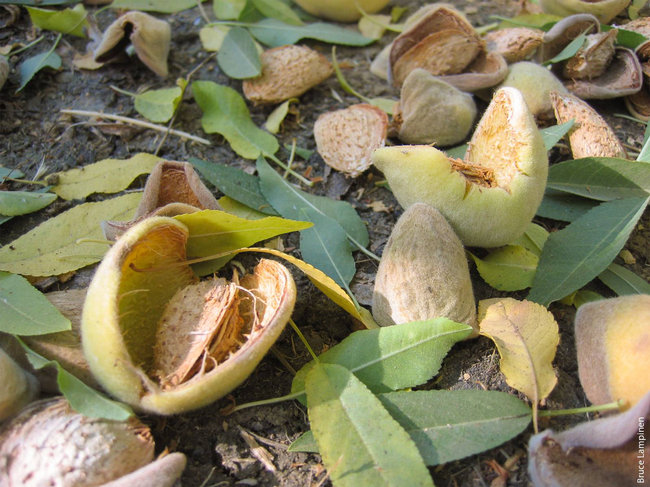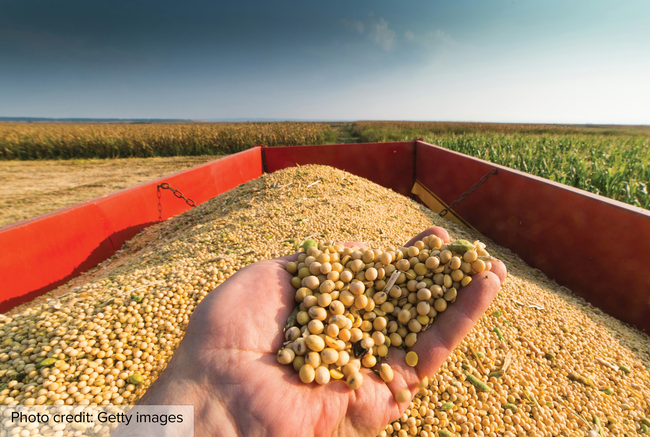Posts Tagged: agriculture
New project aims to use farm waste to fuel bioeconomy
UC ANR to help create database, support technology for sustainable bioproducts and biofuels
In California's Northern San Joaquin Valley, crop leftovers such as almond shells, fruit peels and orchard trimmings can potentially be converted into sustainable bioproducts and biofuels – with the right technology. The philanthropy Schmidt Sciences' Virtual Institute on Feedstocks of the Future, which supports replacing fossil feedstocks with renewable biomass sources, has awarded new funding to a group investigating how to make better use of the diverse agricultural waste in the region.
“This is an important project for California as it quantifies the diverse ‘ingredients' in the North San Joaquin Valley available to fuel the emerging biomanufacturing industry in the state,” said Gabe Youtsey, chief innovation officer for the University of California Agriculture and Natural Resources. “This foundational work will kickstart a completely new innovation bioeconomy in the Central Valley that will create new high-paying jobs for our communities and support a resilient food and agriculture industry through circular biomanufacturing.”
Circular biomanufacturing is a process that uses waste streams as raw materials to create new products.
“Circular means taking waste streams from agriculture such as almond shells or grape pomace, forest waste or food processing waste and using that material as the ‘feedstock' in a fermentation tank to create new bioproducts,” Youtsey explained.
The group, “Building the Circular Bioeconomy in the North San Joaquin Valley” or BioCircular Valley, is co-led by the Department of Energy's Lawrence Berkeley National Laboratory (Berkeley Lab), UC Berkeley, and BEAM Circular, with partners at UC Merced, UC Agriculture and Natural Resources, the Almond Board of California and USDA Agricultural Research Station in Albany.
“California has this incredible diversity of materials, but they aren't well understood – and this makes it difficult to know how to extract the most value out of them,” said Corinne Scown, a senior scientist at Berkeley Lab and UC Berkeley and one of the project leads. “We want to characterize them and make that information available so companies can more easily figure out which feedstock is a good match for them, and then use that agricultural residue to make everything from bio-based polymers and chemicals to sustainable materials and aviation fuels.”
One of the group's goals is to build a publicly accessible database and user-friendly map full of information about different feedstocks, the raw plant materials and biomass that can be broken down and used to make bioproducts. That includes where feedstocks are located, when they are available, how they are currently disposed of, how they perform in different bioreactors, how much sugar or lignin they contain, whether they can be processed with other feedstocks, their greenhouse gas footprint, the potential cost, and much more.
UC ANR's role is to collect data on available feedstocks from forest, agricultural and food processing byproducts, as well as municipal waste streams through sampling and observation.
“We will do this through the extensive knowledge and relationships we have with the California agriculture industry in the North San Joaquin Valley,” Youtsey said. “UC ANR will also support industry outreach as new ‘conversion' technologies are developed, to pilot them with California growers and processors.”
The project will also test ways to improve the flexibility of the conversion process, which breaks down feedstocks to prepare them to make bioproducts. Researchers will apply artificial intelligence to their lab-generated data to improve predictions of how feedstocks can be processed most efficiently or blended together. Being able to use the same technique on different (or mixed) kinds of plant matter would open up ways for companies to make bioproducts more easily.
“Our region has a fantastic combination of diverse and large-scale agricultural activities alongside manufacturing expertise, making this a great place to scale up bioeconomy innovation,” said Karen Warner, CEO of BEAM Circular. “This project will allow us to reduce barriers to using our region's abundant waste streams in more sustainable and valuable ways, so that we can create the products that people need with renewable inputs that are better for the planet.”
The project builds on ongoing efforts to establish biomanufacturing capabilities in the northern San Joaquin Valley, which includes San Joaquin, Stanislaus and Merced counties. Providing better data on how to convert the valley's millions of tons of agricultural waste into valuable products may spur biomanufacturing companies to build facilities nearby, minimizing how far the raw materials have to be moved and generating new jobs.
“This project is designed to benefit a region that has massive potential, but so far has been economically left behind, and to develop a new industry that can provide improvements in air quality, water quality and greenhouse gas emissions as well as significant opportunities in economic equity and the creation of new jobs,” said Blake Simmons, director of Berkeley Lab's Biological Systems and Engineering Division and the BioCircular Valley project lead.
“This kind of research started as basic science, and now we're bringing information and solutions to people who can use them. And the knowledge generated through this project will advance not only the ability of the NSJV to make use of its own regionally available future feedstocks, but will also accelerate the understanding of feedstocks relevant across California and across the U.S.”
The new funds for the project come from the Virtual Institute on Feedstocks of the Future, a partnership between Schmidt Sciences and the Foundation for Food & Agriculture that supports collaboration on research to transform biomass into alternative feedstocks for biomanufacturing. The award is one of five announced today, which total $47.3 million over five years. It is expected that the five teams will collaborate to share best practices and knowledge to boost the bioeconomy at the national level.
“We are grateful for Schmidt's generous support that will help deploy advanced technologies on the ground,” said Alicia Chang, interim president of Berkeley Lab Foundation. “The foundational research and expertise developed through work for the Department of Energy sets the stage for this team to apply their capabilities to bring jobs and lift the community and the economy in the Northern San Joaquin Valley.”
The unintended consequences of clean fuel policies
How policies affect emissions, land use, and the prices of fuel and vegetable oils
Over the last two decades, both the federal government and state governments have enacted policies to reduce greenhouse gas (GHG) emissions in the transportation sector. In a new Special Issue of ARE Update, University of California agricultural economists explore how these federal and state renewable fuel policies have affected biofuel production for motor and aviation fuels and consider how these policies have affected land use and food prices. Their research shows that as U.S. demand for renewable diesel began to outpace supply, consumer prices for vegetable oil—which is used as a feedstock for renewable diesel—surged.
The national Renewable Fuel Standard (RFS) and California's Low Carbon Fuel Standard (LCFS), implemented in 2006 and 2011, respectively, have led to an increase in the amount of biofuels consumed and produced in the United States. While the RFS mandates that a minimum volume of renewable fuels be blended into U.S. transportation fuels, the LCFS sets an annually increasing targeted reduction in transportation-related carbon emissions. The LCFS set a 2030 target date to reduce GHG emissions by 20% through the development of a carbon trading program that requires refiners who produce ‘dirtier' fuels to buy credits from those who produce cleaner (e.g., renewable) fuels.
The authors show that after 2020, whenLCFS credit prices (i.e.,biofuel subsidies) were high, California saw an increasing volume of motor fuel coming from renewable diesel — which previously only made up around 5% of the state's diesel blend. Currently, the retail diesel blend in California is 35% conventional diesel and 65% renewable diesel.
By 2023, renewable diesel was the most consumed renewable fuel in California and also generated the most credits under the LCFS. Because renewable diesel is a perfect substitute for “conventional diesel,” it does not need to be blended with conventional diesel, unlike biodiesel which is chemically different from renewable diesel.
The agricultural inputs used to make renewable diesel can be used not only in the production of motor oil, but also in the development of sustainable aviation fuel (SAF). Additional tax credits set forth in the 2021 Inflation Reduction Act aim to bring about a 100-fold increase in the production of these fuels by by the end of decade. However, the authors of the second article show that current incentives to produce SAFs are not large enough to overcome the opportunity cost of instead using these fuels for on-road use.
After the drastic increase in demand for renewable diesel (up 500% over the last five years), a higher percentage now comes from edible vegetable oils. This increased demand almost certainly plays a role in increasing inflationary pressure on foods such as cooking oils.
“From 2018 to 2024, food-at-home inflation was 24%, but over the same period, fats and oils inflation was 83%,” said UC Davis professor and co-author Jens Hilscher.
The increased demand for these oils from the United States has also led to booms in production in countries such as Brazil and Indonesia, and some of the land conversion into these vegetable oil crops could result in deforestation. Greenhouse gas emissions are a global challenge. The authors show that local biofuel mandates often succeed in moving U.S. consumption of these fuels from one product or region to another without necessarily decreasing emissions at the national level. Their research emphasizes the importance of a coordinated effort to target emission reductions with a careful eye to the indirect consequences that inevitably result from ambitious policies.
To learn more about how federal and statewide renewable fuel policies have affected the demand for biofuels, read the full Special Issue of ARE Update 27(5), UC Giannini Foundation of Agricultural Economics, online at https://giannini.ucop.edu/filer/file/1719507310/21010/.
ARE Update is a bimonthly magazine published by the Giannini Foundation of Agricultural Economics to educate policymakers and agribusiness professionals about new research or analysis of important topics in agricultural and resource economics. Articles are written by Giannini Foundation members, including University of California faculty and Cooperative Extension specialists in agricultural and resource economics, and university graduate students. Learn more about the Giannini Foundation and its publications at https://giannini.ucop.edu.
Ettamarie Peterson: The Queen Bee Who'd Rather Be a Worker Bee
Ettamarie Peterson, fondly known as "The Queen Bee of Sonoma County," will be displaying a bee observation hive at the...

Encouraged by the workshop instructor to hold newly emerged bees, Ettamarie Peterson shows a handful of bees at the Harry H. Laidlaw Jr. Honey Bee Research Facility at UC Davis. (Photo by Kathy Keatley Garvey)

Ettamarie Peterson stands next to Miss Bee Haven, an eight-foot-long ceramic-mosaic sculpture of a worker bee at the UC Davis Bee Haven. It is the work of Donna Billick of Davis. (Photo by Kathy Keatley Garvey)
Fancy Meeting You Here, Mr. Potato Capsid
One potato, two potato, three potato, four... You never know what will pop up in a pollinator garden. Meet Mr. Potato...

Potato capsid, Closterotomus norvegicus, feeding on a chrysanthemum blossom. It also feeds on nettle, clover and cannabis. (Photo by Kathy Keatley Garvey)
UC Davis Entomology and Nematology Retiring Faculty Amass 247 Years of Service
247 years! The seven faculty members honored at the UC Davis Department of Entomology and Nematology's recent retirement luncheon amassed an amazing...

UC Davis distinguished professor James R. Carey, 44 years of service (Photo by Kathy Keatley Garvey)

UC Davis distinguished professor Richard "Rick" Karban, 42 years of service

UC Davis distinguished professor emerita Lynn Kimsey, 35 years of service. (Photo by Kathy Keatley Garvey)

Robert Kimsey, adjunct professor, 35 years of service (Photo by Kathy Keatley Garvey)

UC Davis distinguished professor Jay Rosenheim, 34 years of service. (Photo by Kathy Keatley Garvey)

UC Davis distinguished professor Diane Ullman, 29 years of service. (Photo by Jael Mackendorf)

Professor emerita Sharon Lawler, 28 years of service. (Photo by Kathy Keatley Garvey at UC Davis Picnic Day)





